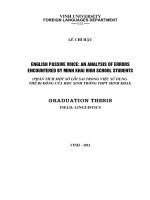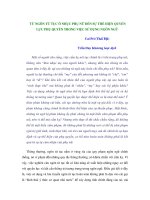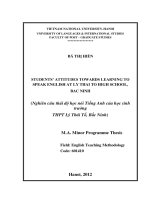Teacher talk at Ly Tu Tan High school, Hanoi and Its implications for effective classroom interactions = Việc sử dụng ngôn ngữ của giáo viên tại trường THPT Lý
Bạn đang xem bản rút gọn của tài liệu. Xem và tải ngay bản đầy đủ của tài liệu tại đây (1.3 MB, 62 trang )
VIET NAM NATIONAL UNIVERSITY, HANOI
UNIVERSITY OF LANGUAGES AND INTERNATIONAL STUDIES
FACULTY OF POST- GRADUATE STUDIES
*****************
LÊ THANH HOA
TEACHER TALK AT LY TU TAN HIGH SCHOOL,
HANOI AND ITS IMPLICATIONS FOR EFFECTIVE
CLASSROOM INTERACTIONS
(VIÊ
̣
C SƯ
̉
DU
̣
NG NGÔN NGƯ
̃
CU
̉
A GIA
́
O VIÊN TA
̣
I TRƯƠ
̀
NG
THPT LY
́
TƯ
̉
TÂ
́
N, H NI V NHNG GI Đ ĐT ĐƯC
SƯ
̣
TƯƠNG TA
́
C HIÊ
̣
U QUA
̉
TRONG LƠ
́
P HO
̣
C)
M.A. Minor Programme Thesis
Field: English Teaching Methodology
Code: 601410
Hanoi, 2012
VIET NAM NATIONAL UNIVERSITY, HANOI
UNIVERSITY OF LANGUAGES AND INTERNATIONAL STUDIES
FACULTY OF POST- GRADUATE STUDIES
*****************
LÊ THANH HOA
TEACHER TALK AT LY TU TAN HIGH SCHOOL,
HANOI AND ITS IMPLICATIONS FOR EFFECTIVE
CLASSROOM INTERACTIONS
(VIÊ
̣
C SƯ
̉
DU
̣
NG NGÔN NGƯ
̃
CU
̉
A GIA
́
O VIÊN TA
̣
I TRƯƠ
̀
NG
THPT LY
́
TƯ
̉
TÂ
́
N, H NI V NHNG GI Đ ĐT ĐƯC
SƯ
̣
TƯƠNG TA
́
C HIÊ
̣
U QUA
̉
TRONG LƠ
́
P HO
̣
C)
M.A. Minor Programme Thesis
Field: English Teaching Methodology
Code: 601410
Supervisor: Nguyen Thi Bich Ngoc, M.A
Hanoi, 2012
iii
ABBREVIATIONS
CLT = Communicative Language Teaching
EFL = English as a Foreign Language
FLT = Foreign Language Teaching
IRF = Initiation/Response/Follow-up
T1: Teacher 1
T2: Teacher 2
T3: Teacher 3
TTT = Teacher Talk Time
STT = Student Talk Time
iv
LIST OF TABLES
Page
Table 1: Description of the teachers 18
Table 2: Description of the subjects of the study 19
Table 3: Students‟ opinion on lecture mode 25
Table 4: Students‟ opinion on their paticipation in class 26
Table 5: Students‟ opinion on wait-time 26
Table 6: Students‟ opinion on the teacher‟s correction 27
LIST OF CHARTS
Chart 1: Amount of teacher talk, student talk and other activities 21
Chart 2: Percentage of teacher talk in total class time 22
Chart 3: Ways of Initiation 23
Chart 4: Ways of Follow-up to No and Incorrect Answer 24
Chart 5: Ways of Follow-up to Correct Answer 25
v
TABLE OF CONTENTS
Page
Acknowledgements i
Abstract ii
Abbreviations iii
Lists of tables and charts iv
PART ONE: INTRODUCTION 1
I. Rationale of the study 1
II. Purpose of the study 2
III. Scope of the study 3
IV. Method of the study 3
V. Significance of the study 3
VI. Organization of the study 4
PART TWO: DEVELOPMENT 5
CHAPTER ONE: LITERATURE REVIEW 5
1.1. The
oretical background of classroom research 5
1.1.1. Interactions in EFL classes 5
1.1.2. The structure of classroom discourse 6
1.2. Theoretical background of Teacher Talk 7
1.2.1. Definition of teacher talk 7
1.2.2. Role of teacher talk 8
1.2.3. Framework of teacher talk 8
1.2.4. Amount of teacher talk 12
1.2.5. Features of teacher talk 13
1.3. Summary 15
CHAPTER TWO: METHODOLOGY 16
2.1. Setting of the study 16
vi
2.2. Method of the study 17
2.3. Data collection 18
2.3.1. Participants 18
2.3.2. Data collection instruments 18
2.3.3. Data collection procedures 20
2.4. Methods of data analysis 20
2.5. Summary 20
CHAPTER THREE: DATA ANALYSIS AND FINDINGS 21
3.1. Data analysis 21
3.1.1. Analysis on teacher talk amount 21
3.1.2. Analysis on ways of teacher talk preferred by teachers and students 23
3.1.3. Analysis on students‟ opinion for effective teacher talk 25
3.2. Findings and Discussions 29
3.2.1. The amount of teacher talk time (TTT) of the total class time 29
3.2.2. Ways of teacher talk preferred by teachers and students 30
3.3. Summary 32
CHAPTER FOUR: IMPLICATIONS 33
4.1. Implications for educational administrators 33
4.2. Implications for the teachers 33
4.3. Implications for the students 37
4.4. Summary 37
PART THREE: CONCLUSION 38
I. Summary of main findings 38
II. Limitations and suggestions for further study 39
References………………………………………………………………………………I
Appendices IV
1
PART ONE: INTRODUCTION
I. Rationale of the study
Language teaching is a complex process involving many interrelated factors. Larsen-
Freeman (2000) points out: language teaching can be summarized into three fields:
language learner/learning (How to learn); language/culture (What to Learn);
teacher/teaching (How to teach). Since the 1960s, the research on classroom discourse has
grown rapidly. Before that, teaching methodology has been explored and an effective
teaching method is tried to be found. Since teaching methods don‟t play a decisive role in
language classrooms (Long, 1981a), the focus has shifted from teaching methods to
teacher talk in classroom process. Just as Ellis (1985:143) points out: “Classroom process
research, as Gaies calls the study of communication in the classroom, has taken a different
form. The earliest was interaction analysis … An alternative approach focused only on the
language used by the teacher when addressing second language learners. It sought to
tabulate the adjustments which occur in teacher talk. ”
Teacher talk is an indispensable part of foreign language teaching in organizing activities,
and the way teachers talk not only determines how well they make their lectures, but also
guarantees how well students will learn (Cook, 2000: 144). According to pedagogical
theory (Cook, 2000; Chaudron, 1988; Zhao, 1998), the language that teachers use in
classrooms determines to a larger degree whether a class will succeed or not. In English
classrooms, teachers‟ language is not only the object of the course, but also the medium to
achieve the teaching objective. Both the organization of the classroom and the goal of
teaching are achieved through teacher talk. Appropriate teacher talk can create harmonious
atmosphere and, at the same time, promotes a more friendly relationship between teachers
and students and, consequently, creates more opportunities for interactions between
teachers and students.
Learning English in Vietnam takes place mainly in classrooms and is usually done under
the guidance and supervision of teachers. Classroom language is the chief source of foreign
language learning and, in some places, the only source. It functions not only as a major
source of language learning but also as a tool by which a foreign language is taught. Until
2
recently, teacher talk in the EFL classroom was considered to be a problematic area for
language teachers. For one time, it was thought that “good” teacher talk meant “little”
teacher talk, since too much teacher talk deprived students of opportunities to speak.
However, it should be the “quality” rather than the “quantity” that counts. “Good teacher
talk” should be judged by how effectively it was able to facilitate learning and promote
communicative interactions in the classroom. Since a better understanding of the use of
teachers‟ language can undoubtedly help students improve their learning, and students can
make a better use of teacher talk to learn the target language, it is necessary to do some
research on teacher talk from both theoretical and practical perspective.
Personally, the researcher always thinks that teacher talk is one of the most important keys
to success in the teaching and learning of a foreign language, so she devoted her time
researching for the thesis: “Teacher Talk at Ly Tu Tan High School, Hanoi and its
implications for effective classroom interactions” with its application to her and her
colleagues‟ teaching of English at Ly Tu Tan High School, where she is working.
II. Purpose of the study
The aim of the research is to investigate the nature of teacher-student interaction in English
classes at Ly Tu Tan High School. In general, it has three purposes. First of all, it is to
investigate the current situation of the teacher talk amount at Ly Tu Tan High School,
Hanoi. Secondly, it aims at finding ways of teacher talk preferred respectively by teachers
and students. Finally, it is to provide teachers with some implications for effective
teaching.
The study aims at answering the following research questions:
1. What is the amount of teacher talk time (TTT) of the total class time in English classes at
Ly Tu Tan High School?
2. What are the ways of teacher talk preferred respectively by teachers and students?
3. What should be done to improve classroom interactions?
3
III. Scope of the study
Teacher talk is such a broad and interesting theme that it requires the work of generations
of scholars and researchers if it is to be thoroughly investigated. Therefore, within the
framework of this paper, the researcher has no ambition of touching upon all aspects of
this fascinating segment of FLT. In this thesis, an attempt was made to study teacher talk
in speaking classes, especially a speaking period of Unit 15: CITIES in the English 10
textbook to investigate the amount of teacher talk in the process of interactions between
teachers and students and to discuss ways of teacher talk in initiating an interaction and
following up a student‟s response preferred respectively by English teachers and 10
th
-form
students at Ly Tu Tan High School.
IV. Method of the study
Both quantitative and qualitative methods are employed to carry out the study. That is, the
data serving analysis and discussion were collected by means of:
- Reviewing the related document on interactions in language classes, structure of
classroom discourse, amount of teacher talk and features of teacher talk.
- Observing classrooms and audio-recording
- Conducting questionnaires
V. Significance of the study
Teacher talk has always been given a significant position in language teaching.
Nevertheless, how to make teacher talk enhance foreign language teaching and learning
effectively often poses great problems to both teachers and students.
This study is important in some aspects. First, it may serve as an empirical study to
investigate teacher talk. Then, it can also be taken as a reference for teachers to get a better
understanding of classroom interactions. Finally, some suggestions for making the
classroom interactions more communicative are provided.
4
VI. Organization of the study
This study is composed of three parts:
Part One: The Introduction presents the rationale, purpose, scope, method, significance
and the organization of the study.
Part Two: The Development consists of four chapters.
- Chapter One: Literature Review establishes the basic theoretical background from the
literature on classroom research and teacher talk.
- Chapter Two: Methodology describes the overall picture of how the research was carried
out from the first step of determining the research design to the last step of gathering the
results. Specifically, this chapter contains details of the setting, the collection of the data
for the research and methods of data analysis.
- Chapter Three: Data Analysis and Findings interprets the results of the study. This
chapter attempts to provide answers to the posed research questions and present the
findings with some comments as well.
- Chapter Four: Implications suggests some ideas for educational administrators, teachers
and students so that teacher talk in class can be improved.
Part Three: The Conclusion summarizes the main findings in the study, emphasizes
implications for more communicative teacher talk and points out the limitations and
provides some suggestions for further study on the field.
5
PART TWO: DEVELOPMENT
CHAPTER 1: LITERATURE REVIEW
1.1. Theoretical background of classroom research
1.1.1. Interactions in EFL classes
It is acknowledged that the FL classroom differs from other subject classrooms in that the
target language is both what is being taught and the means by which it is being taught
(Allwright & Bailey, 1991). Taking the language as the learning target, competent learners
are expected not only to be good at the linguistic knowledge, but also to be competent in
language use, which requires adequate exposure to the language. “In situations where the
target language is seldom used outside the classroom, the students exposure to the target
language is therefore mainly in the classroom” (Tsui, 1995:12). It is, therefore, crucial to
have a communicative FL classroom.
A common theme underlying different methods of language teaching is that second
language learning is a highly interactive process (Richards & Lockhart, 1994: 138). In
language classroom settings, the teacher-learner interactive pattern is the most traditional
pattern. In this pattern of interaction, the teacher plays the role of an expert, providing
learners with direction and doing most of the talking and commenting (Lemke, 1990). In
consequence, such communication in the classroom influences students‟ perception of and
participation in classroom activities (Farrell, 2002). Through their interactions with each
other, the teacher and students construct a common body of knowledge. They also create
mutual understandings of their roles and relationships, the norms and expectations of their
involvement as members in their classrooms.
Malamah-Thomas (1987) points out that classroom interaction is not a one-way action and
reaction but a reciprocal process. Only when the participants constantly adjust their
reactions to each other‟s previous actions can communication go on. He illustrates the
mutual reactions between the teacher and the student(s) in the following figure:
6
(Malamah-Thomas, 1987: 39)
1.1.2. The structure of classroom discourse
In their research, Sinclair and Coulthard (1975) find that most interactions that take place
in the classroom follow a three-part pattern, i.e. the question (Initiation), the answer
(Response) and the feedback (Follow-up), and later widely referred to as the IRF model by
Mc Carthy and Walsh (2002). This exchange model is typically initiated by the teacher,
followed by a response from the student, and then followed by the teacher‟s feedback. The
interaction for one topic may involve more than one IRF cycle. For example, in a class
after the students discussed an essay written by one of them, the teacher tried to pull the
students back to the teacher-class format so as to allow students to “share” the fruits of
their labours in groups (Katz, 1996: 68).
Although classroom interactions may emerge in a variety of ways, IRF seems to be a most
common exchange pattern in classroom discourse. This tends to be a teacher‟s “default
option” unless the teacher makes a deliberate change and uses some other interactional
patterns. Van Lier (1996) commented that the IRF sequence was effective in enabling the
teacher to lead students in carefully designed direction and progression, to provide students
with immediate feedback on their performances and to maintain an orderly lesson.
However, IRF sequence is not without its criticism. It is thought to limit meaningful
student participation because teachers have the rights to initiate speech, to distribute turns
and evaluate students‟ utterances, whereas students have much more restricted
participation rights, opportunities to ask questions and negotiate meaning (Cullen, 2002;
McCarthy, 1991).









